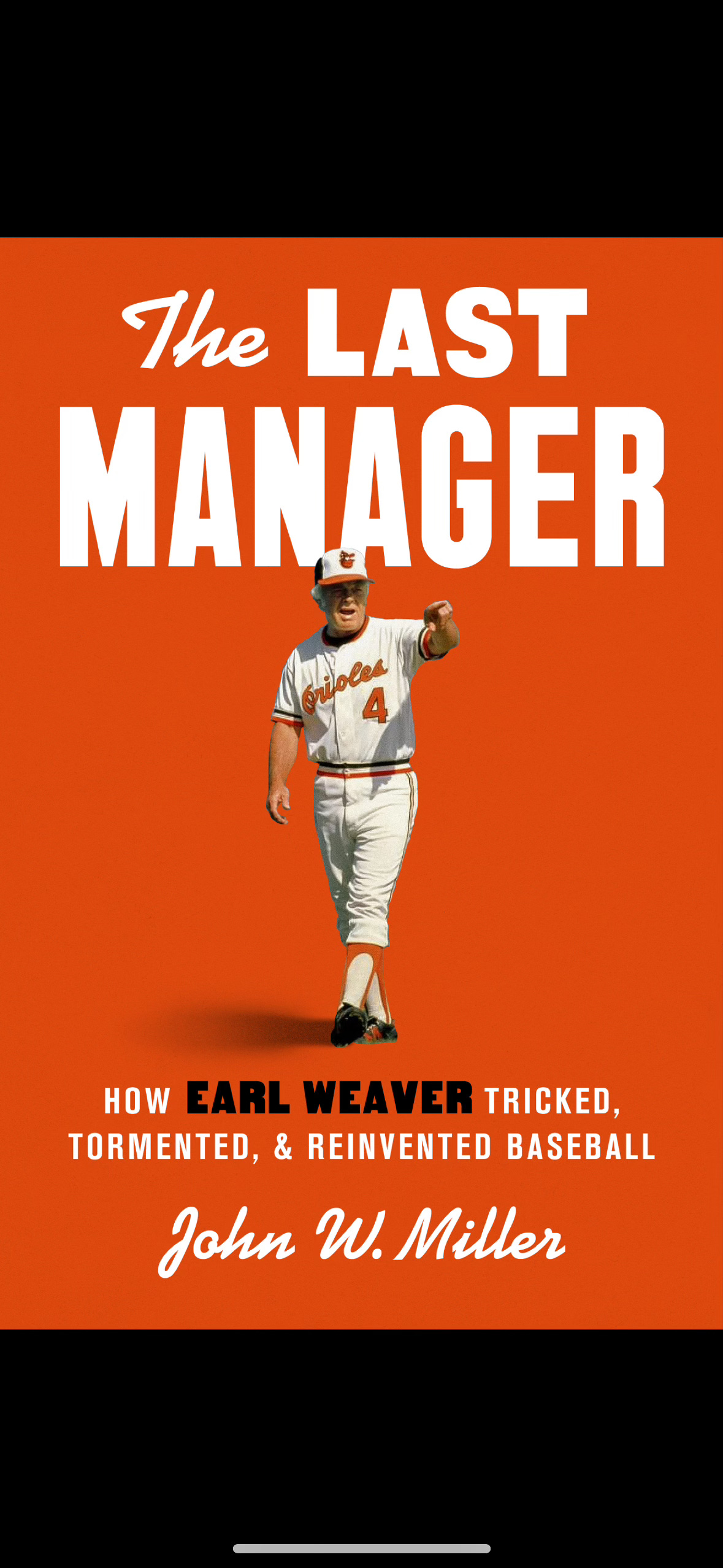Inside the New Earl Weaver Biography
In a guest post, the author of a forthcoming biography of the Orioles' Hall of Fame manager explains how his book came about - and what he discovered.
Like any Gen-X Orioles fan (I was born in 1977), I grew up on stories of Earl Weaver. I read the Hall of Fame manager’s memoirs, as well as stories by writers such as my host here John Eisenberg (I’ve subscribed to The Bird Tapes and so should you), Terry Pluto and Thomas Boswell.
Reading about Earl in the 1990s and 2000s, after his career was over, felt like living in Italy after the fall of Rome and learning about how Julius Caesar conquered Western Europe. Consider the Orioles’ record under Earl compared to their record under managers not named Earl:
1901–-1953 (in Milwaukee and St. Louis): 70.1 wins per 162 games
1954-–1967 (Orioles before Earl): 81.9 wins per 162 games
1968-–1982; 1985-–1986 (Earl): 94.5 wins per 162 games
1987-–2023 (after Earl): 76.8 wins per 162 games
When Weaver died in 2013, I was living in Pittsburgh, covering steel and mining for the Wall Street Journal. An editor on the sports desk knew I was an Orioles fan who’d also played baseball at Mount St. Mary’s in Emmitsburg, Maryland, and briefly scouted in Europe for the Orioles. He asked me to write Weaver’s obituary for the paper.
As I wrote the piece, I realized I’d been thinking about Earl Weaver for most of my life, both as a fan and as a baseball player and coach. I also realized his legacy had never been properly examined. The only other biography was Pluto's The Earl of Baltimore, which came out in 1981, five years before Weaver retired. So much had happened since then, and baseball’s analytics revolution had only enhanced Weaver's reputation.
In late 2021, I decided to do something about it. I flew to Ft. Lauderdale and had dinner with Mike Weaver, Earl’s son. I reread Earl’s books, Boswell's columns, and Eisenberg's oral history, the book serving as the foundation of the Bird Tapes. I put together a nonfiction book proposal, which includes a summary, chapter synopsis, marketing plan, and chapter synopsis.
My initial idea was to tell readers what made the Orioles of the Earl Weaver Era so good. I’d tell you about Belanger’s defense, Palmer’s pitching, and Singleton’s murderous offense.
But when I started contacting agents and publishers, I couldn’t sell this book. The story felt too familiar. People already knew this Earl. The rejections piled up.
It took a conversation with Pulitzer Prize-winning author Jonathan Eig to make the adjustments I needed to make the proposal interesting and attractive enough. What was most interesting about Weaver, Eig pointed out, wasn’t his successes. It was the other stuff. The hardscrabble youth. The two decades he spent in the minor leagues as a player, coach and manager. His real struggles with alcohol, and his temper.
Above all, what was interesting was this question: How did a failed minor league second baseman with a drinking problem from the wrong side of Depression-era St. Louis become, in Tom Verducci’s words, the “Copernicus of Baseball”?
Once I adjusted the frame, the story fell into place. In late 2022, I sold the book to Simon & Schuster and went to work on reporting the story.
I spent 2023 on the road in search of Earl Weaver. What I discovered was fascinating.
I traveled to St. Louis, where Earl was born in 1930, and saw the street where he grew up. I dug up police reports that showed that his mentor, his uncle Bud Bochert, was a mobster who was part of Al Capone’s network and ran illegal baseball betting operations. Earl Weaver was never found to have bet on baseball, but he certainly learned a thing or two about probability theory from hanging out with Uncle Bud.
In St. Louis, I met Earl’s grandson, Mike Leahy, also known as Clownvis. Like Earl, Clownvis is a showman. His act: half-clown, half-Elvis.
Over the following year, I traveled to Albany, in southern Georgia, where Earl started his pro baseball career at age 17, and also went to Thomasville, Georgia, where Earl helped develop the Oriole Way at the team’s minor league camp in the late 1950s and early 1960s. I interviewed the son of Earl’s high school coach, the sound technicians behind the Haller hot mic, and the Electric Arts tech engineers who developed Earl Weaver Baseball, a popular video game. In 1986, they welcomed Earl to Redwood City, California, where he explained baseball on a blackboard to them — a voice from the old world of baseball educating the new.
The video game, a breakthrough piece of entertainment as the first season-length sports simulation ever made, stands as a symbol of how Earl Weaver is baseball’s ultimate bridge character, between the old era of Dizzy Dean and Babe Ruth and the 21st century version of millionaire ballplayers and iPad scouting reports.
Earl Weaver was the only manager to hold his job in the five years before and the five years after free agency upended baseball in 1976.
I drove to Elmira and Rochester, New York, where Earl managed in the minor leagues, and Perry Hall, Maryland and Hialeah, Florida, where he lived, and, of course, Cooperstown, New York, where he is enshrined as a baseball immortal.
Of course, I also interviewed Cal Ripken Jr., Ken Singleton, Tippy Martinez and a couple dozen other players so I could tell the inside story of Weaver’s wild and winning Oriole clubhouses. I wanted to avoid repeating the stock stories and cliches, but make no mistake, this is an Orioles book for Orioles fans.
After spending three years reading and reporting Earl Weaver’s story, I am still fascinated by his life and achievements. He is still, by so many measures, the greatest manager in modern baseball history, with the highest winning percentage of any manager with over 1,000 wins since the advent of divisional play in 1969:
Earl Weaver .583 (1,480-1,060)
Davey Johnson .562 (1,372-1,071)
Bobby Cox .556 (2,054-2,001)
Billy Martin .553 (1,253-1,013)
Charlie Manuel .548 (1,000-826)
As you’ll read in The Last Manager, modern managers (I interviewed over a dozen for the book) still revere his legacy.
Not only was Earl Weaver the first manager to use data aggressively, he was also the first to use a radar gun. He became such a major cultural celebrity that he was a Playboy magazine interview of the month in 1983, when that meant something. Other Playboy interview subjects that year included TV mogul Ted Turner, bestselling writer Stephen King and Nobel Prize-winner Gabriel Garcia Marquez.
Of course, Earl Weaver has always been that important and famous to Oriole fans, which is why I can’t wait for you to read the book and enlarge the conversation about somebody we fans still rightly consider a hero.
Jim Palmer recently tweeted a picture of himself reading a preview copy of the book in front of a lemon tree. It was fitting. Sour lemons or sweet lemonade, Palmer and Weaver stand for the best work ever done by anybody wearing an Orioles uniform.
(Note: The book will be out in March, but you can help make it a bestseller by preordering now.)
John W. Miller is a Pittsburgh-based writer and high school baseball coach. You can follow him on X at @jwmjournalist







John, I love the fact that you're covering more than just the Bird Tapes in your space. Keep it going.